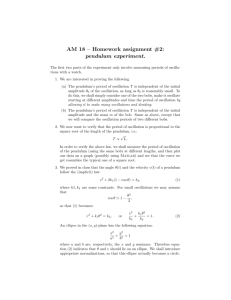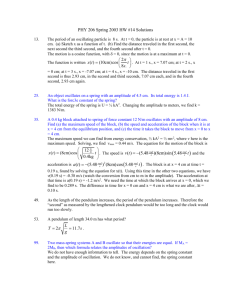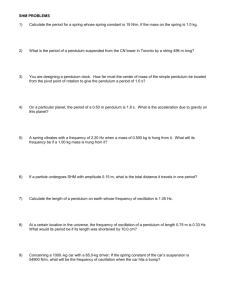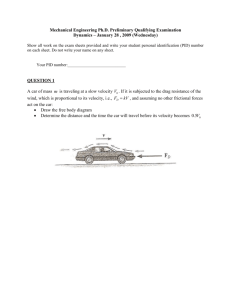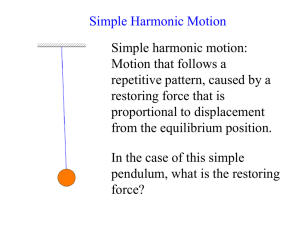Apr23-Discussion
advertisement
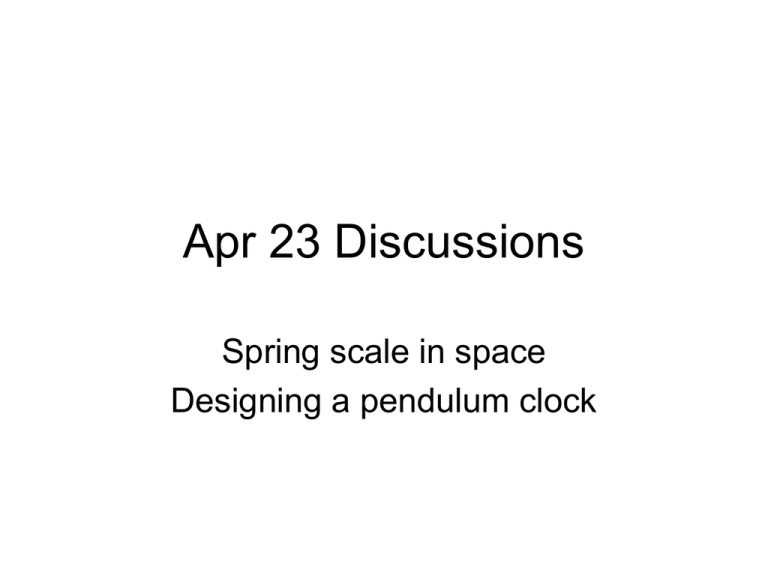
Apr 23 Discussions Spring scale in space Designing a pendulum clock Q1: The oscillation period of a mass on a spring is related to the mass and spring constant by: • A) B) C) k T 2 m m T 2 k D) 1 T 2 m k 1 T 2 k m The oscillation period of a mass on a spring is related to the mass and spring constant by: • A) B) C) m T 2 k D) Higher mass should slow the oscillations and increase the period. Higher k should speed the oscillation rate and decrease the period. P1: Springs in Space • Working for NASA, you are tasked with designing a scale that will work in space. You remember that a standard scale that measures weight will not work, then you recall that a mass on a spring will oscillate at a frequency that depends on the mass (and the spring constant). What spring constant should you choose so that a 1.0 kg mass has an oscillation period of 1.0 second? What would the period be for a 10.0 kg mass oscillating on that spring? Springs in Space-2 • Recall that the period of a mass on a spring is: m T 2 k • Therefore, the spring constant that will give a particular period is: 2 2 2 2 kg N k m 1 kg 39.5 2 39.5 T 1 s s m • For a 10 kg mass, the period will be 10 kg T 2 3.16 s 2 39.5 kg/s Q2:The period of a pendulum depends (primarily) on… A) the length B) the mass C) the amplitude of the swing D) all of these Q2:The period of a pendulum depends (primarily) on… A) the length B) the mass C) the amplitude of the swing D) all of these (Not on mass; for small amplitudes, the the period does not change very much). P2: Pendulum Ponder • You are designing an old-school pendulum clock that depends on the regular oscillations of a pendulum to keep time. Your pendulum length will be set so that it completes the tick in one second and the tock in one second (that is the period must be two seconds). A) What length should the pendulum be (assuming g=9.80 m/s2)? B) Suppose you want your pendulum clock to work at other locations on Earth. Because the local value of g varies by ±0.02 m/s2 (its lower near the equator and at hight altitude, higher near the poles), the length of the pendulum must be adjustable. How much adjustment do you need to allow for in the length of your pendulum? Pendulum Ponder-2 • A) the period depends on g and the length by: L T 2 g 2 T 2 2 2 s L g (9.80 m/s ) 0.993m 2 2 • B) Note that the length is proportional to the value of g. Therefore, if g can vary by ±0.2%, the length must be tunable to the same degree: ±0.2% of 1 meter is ±2 mm (not a negligible amount! If you did not allow for it, your clock could run up to ±0.2% off, or about ±2.9 minutes per day). Q3: The speed of a wave on a rope depends on all of the following except: A) gravitational acceleration g B) the total mass of the rope C) the tension in rope D) the length of the rope Q3: The speed of a wave on a rope depends on all of the following except: A) gravitational acceleration g Formula for speed of a wave on a rope: FT v m/ L P3: Waves on a Gondola Ride A ski gondola is connected to the top of a hill by a steel cable of length 620 m and diameter 1.5 cm. As the gondola comes to the end of its run, it bumps into the terminal and sends a wave pulse along the cable. It is observed that it took 16 s for the pulse to return. (a) What is the speed of the pulse? (b) What is the tension in the cable? Info: The density of steel is 7800kg/m3. (a) The speed is given by the total distance traversed, which is twice the length of the cable, divided by the time. x 2(620 m) v 77.5m / s t 16 s FT m 2 FT v . (b) Use v m/ L L What is m/L? m=(Volume) = r2L m/L= r2 = (0.0075m)2(7.8×103kg/ = 1.38kg/m So FT=(1.38kg/m)(77.5m/s)2=8289N


